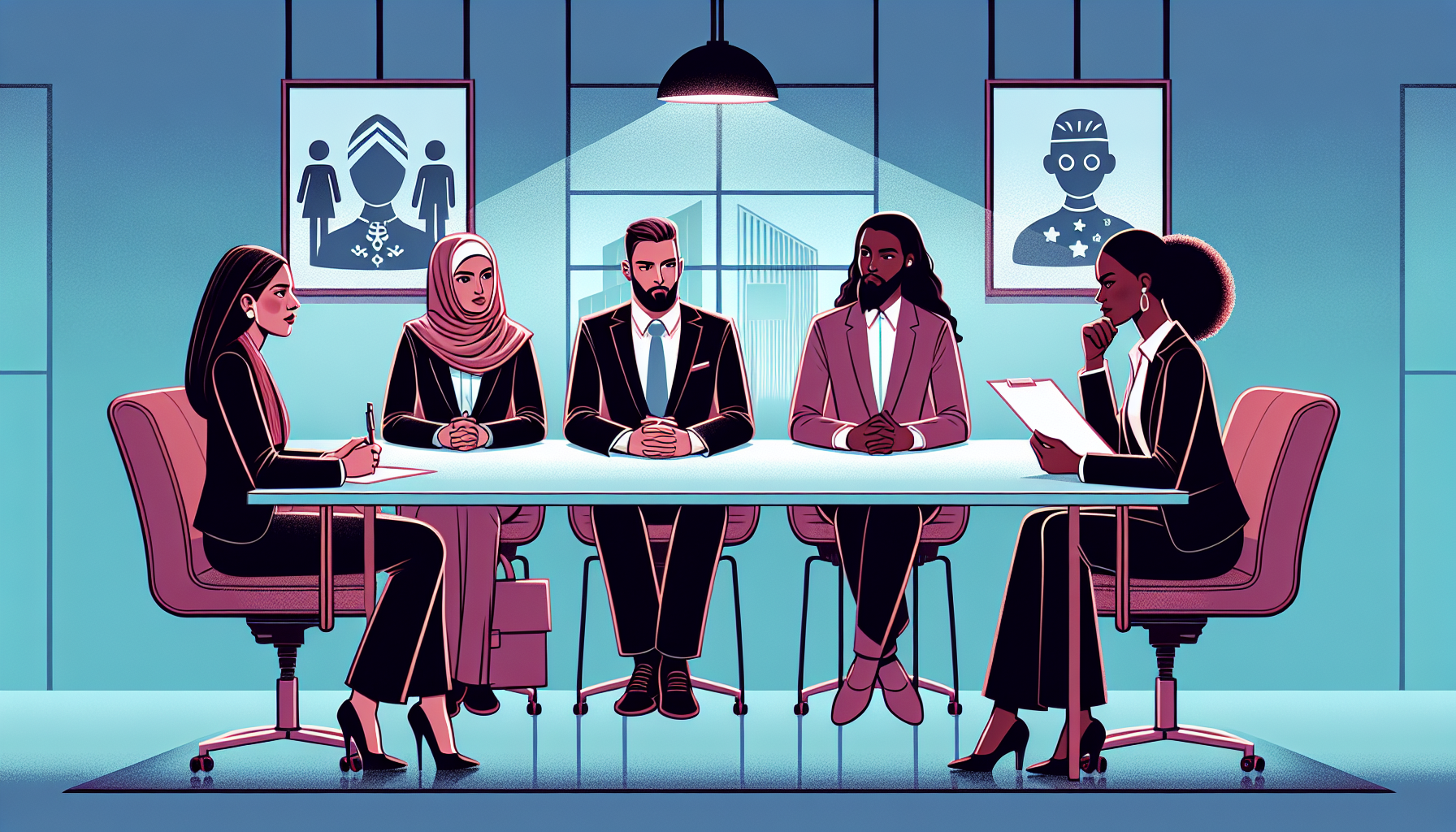How does culture fit in hiring shape the future of your team and organization? In this deep dive, we uncover the critical role of culture fit in attracting compatible talent that enhances team synergy and aligns with your company’s mission, ensuring a smooth and strategic hiring process.
Key Takeaways
- Culture fit refers to the alignment of an employee’s beliefs, behaviors, and skills with the company’s core values and culture, playing a key role in recruiting, employee satisfaction, and turnover rates.
- Assessing cultural fit during the hiring process involves a balance of structured interviews, behavioral questions, incorporating team feedback, and balancing candidate’s skills with their potential cultural contributions.
- Continuing to foster an inclusive, diverse, and healthy workplace culture is important post-hire, but an overemphasis on culture fit can lead to homogeneity and underutilize the benefits of diversity and diverse skill sets.
Decoding Culture Fit in the Hiring Landscape

Culture fit in an organization signifies how well employees’ beliefs and behaviors align with the company’s core values and company culture. Cultural fit involves:
- Aligning with the company’s key values
- Fostering positive team dynamics
- Acquiring specific skills
- Embracing shared goals
This alignment is crucial for attracting top talent and plays a significant role in ensuring new hires are quickly integrated and comfortable in their new roles.
Cultural fit is a cornerstone in recruiting, contributing to improved employee satisfaction and reduced turnover rates. When team members share a cultural fit, it results in enhanced team cohesion and collaboration, leading to more effective teamwork and the enhancement of innovation within the team. Furthermore, assessing cultural fit during the hiring process is recognized as paramount due to its profound effects on the organization. Ensuring new hires fit the company culture is vital for preventing the negative effects of costly turnover and a disruptive workplace.
The importance of culture fit extends beyond mere alignment with company values. It enhances productivity and cultivates an environment of empowered employees. Finding the right culture fit is essential for creating a positive and impactful working environment, as it aligns with company values and facilitates a seamless hiring process.
Defining Corporate Culture and Its Impact on Hiring
Corporate culture encompasses a variety of organizational elements, including mission statements, goals, workplace atmosphere, management approaches, and employee conduct. These factors collectively define the distinct identity and values of an organization. Understanding a company’s culture involves recognizing its values, vision, working methods, communication styles, belief systems, habits, and preferred behaviors. Leadership plays a key role in defining and sustaining corporate culture, with both top executives and team leaders being critical in its development.
Corporate culture, also known as business culture, is seen as the atmosphere within the workplace, influenced by the collective behaviors and values of the workforce, and is fundamental in attracting and retaining talent. This atmosphere, which is also referred to as the company’s culture, organization’s culture, or organizational culture, affects major business decisions and leader behaviors, including hiring, firing, and promotions, indicating its impact on the overall hiring strategy.
A strong company culture can lead to positive work environments, greater employee satisfaction, and the retention of highly skilled employees.
Aligning Candidate Values with Organizational Goals
Aligning candidate values with the company’s mission and vision increases the likelihood that the employee will be genuinely invested in the company’s goals. This alignment not only enhances job satisfaction but also ensures that employees are more likely to contribute positively to the organization. Candidates often value company culture more than salary, affecting their job satisfaction and their decision to apply.
When candidates’ values resonate with the company’s ethos, they are more likely to feel a sense of belonging and purpose within the organization. This intrinsic motivation drives them to perform better and stay longer, ultimately benefiting both the employee and the organization. Thus, aligning candidate values with organizational goals is a critical step in the hiring process.
The Role of Culture Fit in Employee Journey
Cultural fit in an employee journey refers to the alignment of an employee’s work style with the organization’s unique work style. When hiring, prioritizing technical skills over cultural fit can lead to team cohesion and collaboration challenges, impacting the employee’s integration and growth within the company. Therefore, it is essential to consider cultural fit as a significant factor in the hiring process to ensure seamless integration and growth within the company.
By prioritizing cultural fit, organizations can foster a positive work environment where employees feel valued and supported. This approach not only enhances job satisfaction but also contributes to the overall success and growth of the company. A strong culture fit ensures that employees are aligned with the company’s core values and are more likely to thrive in their roles.
Crafting the Interview Process to Assess Cultural Alignment

Assessing cultural alignment during the interview process involves structured questions, team feedback, and balancing skills with cultural contributions. Unconscious biases can significantly affect hiring decisions and judgments, challenging the diversity of recruitment. Structured interviews and educational programs about biases can aid recruiters in making more objective and fair assessments of cultural fit.
Using intentional interview questions that reveal a candidate’s values, approaches, and career aims can expose their compatibility with the company’s culture. This section will explore practical steps to incorporate cultural fit assessments in interviews, including behavioral questions, team feedback, and balancing skills with cultural contributions.
Behavioral Questions That Reveal Culture Fit
Behavioral and motivation-indicator questions in interviews serve crucially to uncover the underlying values, behaviors, and motivations of candidates, thereby helping assess their cultural fit with the organization. Some effective questions to ask include:
- What are your professional goals?
- How would you describe your communication style?
- How do you align with our company values?
- What are your leadership preferences?
- How do you approach challenges?
- How do you balance work and personal life?
These questions can provide valuable insights into a candidate’s suitability for the role and the company culture.
Inquiring about the candidate’s management style, their collaboration methods, and how they handle stress and deadlines can offer insights into their potential fit with the existing company culture. The interview process should emphasize evaluating how a candidate’s approach to their work and their past experiences can enhance their skill set and also contribute positively to the company culture. Using an interview scorecard assists hiring managers in the objective assessment of a candidate’s cultural fit based on structured evaluation of their responses to behavioral questions.
Incorporating Team Feedback in the Hiring Decision
During the hiring process, interview questions can be specifically designed to understand candidates’ contributions to team dynamics. Utilizing a collaborative team approach in hiring employees ensures that new hires are a good fit for the team, promoting synergy and upholding the company’s core values.
Incorporating team feedback in hiring decisions promotes greater job satisfaction and a cohesive team environment. This collaborative approach allows hiring managers to gain multiple perspectives on a candidate’s potential fit, ensuring that the new hire aligns with both the company’s culture and the team’s dynamics.
Balancing Skills and Cultural Contributions
Balancing technical skills with cultural contributions ensures a well-rounded evaluation of candidates. Recruiters should utilize a range of evaluation methods, including interviews and technical assessments, to balance cultural fit with technical expertise. This holistic approach maximizes the potential for success within the organization.
A performance-values matrix can be used to holistically evaluate candidates by considering both cultural alignment and job performance. This balance not only ensures that candidates have the necessary skills but also that they can contribute positively to the company’s culture, fostering a dynamic and inclusive work environment.
The Strategic Advantage of Embracing Diversity Through Culture Add

Adopting a ‘Culture Add’ approach in hiring strategies emphasizes identifying candidates who bring in novel viewpoints to complement and expand the organization’s culture. This philosophy promotes hiring decisions that value candidates’ unique and constructive attributes, values, beliefs, and behaviors. By considering ‘Culture Add’ during the hiring process, organizations aim to find individuals who can not only echo the company’s ethics and values but also present singular traits that contribute to a vibrant and varied culture.
A ‘Culture Add’ hiring philosophy can enhance team dynamics and stimulate organizational growth by appreciating the distinctive contributions of each individual. Assessing how candidates have previously worked with diverse groups of colleagues provides valuable insight into their ability to integrate into a diverse environment and contribute to a culturally rich team.
Overcoming Challenges in Diverse Hiring Practices
Organizations often struggle with attracting candidates from diverse backgrounds, which can result in a less diverse applicant pool. Widening the pool of candidates can be achieved by partnering with minority-focused organizations and utilizing diverse job boards to advertise vacancies. Articulating the company’s culture and values clearly, with a strong emphasis on diversity and inclusion, helps maintain a balanced and varied talent pool.
To attract millennials, companies can:
- Introduce work-life balance initiatives
- Prioritize professional growth opportunities
- Emphasize the company’s mission, which contributes to a culture that supports diversity hiring practices.
Measuring the Positive Impact of Cultural Diversity
Cultural diversity in an organization enhances creativity and problem-solving by bringing together a wide array of perspectives. Companies with diverse and inclusive teams experience better employee retention and are more attractive to prospective job candidates. Diversity within a company can be measured across various dimensions, including:
- age
- gender
- race
- education
- job level
- work habits
- communication styles
By fostering a vibrant and inclusive work environment, organizations, including small business owners, can:
- Leverage the unique strengths and perspectives of their employees
- Enhance job satisfaction
- Drive innovation
- Gain a competitive advantage in the market.
Ensuring a Healthy Workplace Culture Beyond the Hire

Integrating diverse talent into company culture presents challenges that need to be managed to maintain a positive workplace. Inclusive work environments and support systems like mentorship programs are essential for the retention of a diverse workforce. Identifying cultural misalignment is critical to building a high-performing organization and preventing employee disengagement.
Regular communication between managers and employees regarding goals and performance is vital for maintaining a healthy workplace culture. Some strategies for maintaining a positive work culture include:
- Recognizing employee contributions and achievements
- Fostering loyalty and satisfaction
- Promoting diversity and inclusion
- Recognizing and rewarding employees
These strategies contribute to maintaining a positive work culture.
Fostering Growth and Maintaining Core Values
To ensure the longevity of a company’s culture, fostering employee growth strategies in alignment with core values is essential. Organizations facilitate employee development by defining clear departmental objectives, creating opportunities for skill enhancement, and having managers who embody company values.
The preservation of a company’s core values and culture is achieved through their prominent integration throughout all stages of an employee’s journey, including regular interactions within the company. Maintaining established company traditions and hiring people who are not only skillful but also genuinely invested in their coworkers supports the reinforcement of the company’s core values.
Recognizing and Addressing Cultural Misalignments
Lack of trust and accountability in leadership and a disconnect between employee expectations and company strategy can herald a misaligned workplace culture. Signs of cultural misalignment include poor leadership trust, a disconnect in expectations, and contrasting strategies which affect cohesion and productivity.
Open and honest communication is a critical tool for recognizing cultural misalignments within a team or organization. Through candid discussions prompted by open communication, management can effectively address and recalibrate to resolve cultural misalignments.
The Pitfalls of Overemphasis on Culture Fit
An excessive focus on cultural fit during hiring can lead to overlooking a candidate’s competency, skills, and experience, which are crucial for business success. When selections are made strictly based on alignment with the existing culture, the result can be a team lacking in diversity, which may limit creativity and innovation.
HR professionals have reported skepticism regarding the effectiveness of diversity and inclusion programs, indicating a possible disconnect between theoretical diversity initiatives and practical application. Incorporating diversity, equity, and inclusion (DEI) into the hiring process is important to prevent discriminatory practices that can arise from hiring based solely on shared backgrounds or experiences.
Prioritizing cultural fit over technical skills can result in hiring individuals who struggle to perform their job tasks effectively.
Leveraging Technology in Cultural Fit Assessment

Leveraging AI technology in cultural fit assessments offers objective insights and reduces biases, enhancing the precision of evaluations. AI tools used for assessing cultural fit include technologies like natural language processing (NLP), machine learning, and sentiment analysis. Specific AI tools such as Pymetrics and HireVue utilize games and video interviews to evaluate candidates’ behavioral patterns for cultural alignment. These technologies analyze candidates’ responses and relevant data to objectively evaluate alignment with the company’s culture.
Using AI in cultural fit analysis offers a more accurate and efficient evaluation, provides objective insights, and can help to reduce unconscious biases. Emerging technologies like emotional intelligence AI and advanced predictive analytics promise to further enhance the precision of cultural fit evaluations. Best practices for the adoption of AI in cultural fit assessments involve careful planning, integration with existing systems, adequate training for HR teams, and continuous monitoring.
Summary
Decoding and mastering culture fit in hiring practices involves understanding how well potential employees align with the company’s core values and mission. From defining corporate culture and aligning candidate values with organizational goals to crafting interview processes that assess cultural alignment, every step is crucial for building a cohesive and productive workforce. Embracing diversity through a ‘Culture Add’ approach further enhances team dynamics and organizational growth, while maintaining a healthy workplace culture beyond the hire ensures long-term success.
However, it’s important to strike a balance and avoid overemphasizing culture fit at the expense of technical skills and diversity. Leveraging technology in cultural fit assessments can offer objective insights and increase the accuracy of evaluations. By integrating these practices, organizations can create a vibrant, inclusive, and high-performing work environment. Remember, the goal is to build a team that not only fits but also adds to the company culture.
Frequently Asked Questions
What is culture fit in hiring?
Culture fit in hiring refers to how well a candidate’s beliefs and behaviors align with the company’s core values and culture. It is important to ensure that new hires can seamlessly integrate into the existing organizational culture.
Why is aligning candidate values with organizational goals important?
Aligning candidate values with organizational goals is important because it leads to higher job satisfaction and a genuine investment in the company’s mission and vision. This fosters a stronger and more productive work environment.
How can behavioral questions reveal a candidate’s culture fit?
Behavioral questions can reveal a candidate’s culture fit by uncovering their values, motivations, and professional goals, providing insights into their compatibility with the company’s culture. This helps in assessing how well they align with the organization’s values and working environment.
What are the benefits of embracing diversity through a ‘Culture Add’ approach?
Embracing diversity through a ‘Culture Add’ approach enhances team dynamics, stimulates organizational growth, and values unique contributions from each individual, leading to a more inclusive and innovative workplace.
How does leveraging AI in cultural fit assessments help?
Leveraging AI in cultural fit assessments helps by offering objective insights, reducing biases, and enhancing the precision of evaluations, resulting in a more accurate and efficient hiring process.
About InTech Ideas
If you’re looking to elevate your tech strategy and drive business growth, InTech Ideas is here to help. We offer a comprehensive suite of services, including Software Development Teams, Product Development Fast Track, and Product Leadership & Advisory. Whether you need to scale your development team, fast-track your product, or bring in expert leadership, we provide tailored, people-first solutions that align with your company’s goals. Learn more about how we can support your journey by exploring our services or contacting us today to discuss your specific needs.

